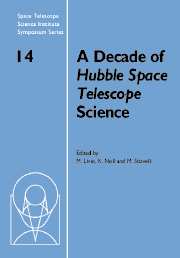Book contents
- Frontmatter
- Contents
- Participants
- Preface
- HST studies of Mars
- HST images of Jupiter's UV aurora
- Star formation
- SN1987A: The birth of a supernova remnant
- Globular clusters: The view from HST
- Ultraviolet absorption line studies of the Galactic interstellar medium with the Goddard High Resolution Spectrograph
- HST's view of the center of the Milky Way galaxy
- Stellar populations in dwarf galaxies: A review of the contribution of HST to our understanding of the nearby universe
- The formation of star clusters
- Starburst galaxies observed with the Hubble Space Telescope
- Supermassive black holes
- The HST Key Project to measure the Hubble Constant
- H0 from Type Ia supernovae
- Strong gravitational lensing: Cosmology from angles and redshifts
Globular clusters: The view from HST
Published online by Cambridge University Press: 13 August 2009
- Frontmatter
- Contents
- Participants
- Preface
- HST studies of Mars
- HST images of Jupiter's UV aurora
- Star formation
- SN1987A: The birth of a supernova remnant
- Globular clusters: The view from HST
- Ultraviolet absorption line studies of the Galactic interstellar medium with the Goddard High Resolution Spectrograph
- HST's view of the center of the Milky Way galaxy
- Stellar populations in dwarf galaxies: A review of the contribution of HST to our understanding of the nearby universe
- The formation of star clusters
- Starburst galaxies observed with the Hubble Space Telescope
- Supermassive black holes
- The HST Key Project to measure the Hubble Constant
- H0 from Type Ia supernovae
- Strong gravitational lensing: Cosmology from angles and redshifts
Summary
Globular clusters represent only a small fraction of the total mass in their parent galaxy, but provide a vast array of tests for stellar physics, dynamics, and galaxy formation. This review discusses the prominent accomplishments of HST-based programs:
The definition of precise fiducial sequences in the HR diagram, extending down to the hydrogen-burning limit,
Discovery of the upper white dwarf cooling sequence in several clusters,
Discovery of a highly consistent IMF on the lower main sequence,
Definitive age measurements for the oldest clusters in the outermost halo of the Milky Way, the Magellanic Clouds, and the dwarf elliptical satellites of the Milky Way,
Elucidation of the innermost structure of M15 and other core-collapsed clusters,
Discovery of surprisingly large “anomalous” populations of stars within dense cluster cores: extended blue horizontal-branch stars, blue stragglers, and others,
The first reliable color-magnitude studies for globular clusters in M31, M33, and other outlying Local Group members,
Discovery of massive young clusters in starburst galaxies with ages as small as 1 Myr,
Measurement of metallicity distribution functions among globular cluster systems in many giant E galaxies—bimodality is common, but details differ strongly, and
Deep imaging of cluster luminosity distributions in gE galaxies in Virgo, Fornax, and other Abell clusters as distant as Coma.
Information
- Type
- Chapter
- Information
- A Decade of Hubble Space Telescope Science , pp. 78 - 100Publisher: Cambridge University PressPrint publication year: 2003
Accessibility standard: Unknown
Why this information is here
This section outlines the accessibility features of this content - including support for screen readers, full keyboard navigation and high-contrast display options. This may not be relevant for you.Accessibility Information
- 4
- Cited by
